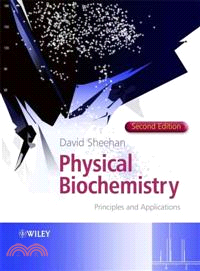Physical Biochemistry - Principles And Applications 2E
商品資訊
定價
:NT$ 8433 元優惠價
:90 折 7590 元
若需訂購本書,請電洽客服 02-25006600[分機130、131]。
相關商品
商品簡介
作者簡介
目次
商品簡介
"As will be seen, there is not much missing here. I thought that the sections were well balanced, with rarely too much or too little on a given topic...This is a text to be welcomed by both teachers and students." BIOCHEMISTRY & MOLECULAR BIOLOGY EDUCATION (on the first edition)
The second edition of this successful textbook explains the basic principles behind the key techniques currently used in the modern biochemical laboratory and describes the pros and cons of each technique and compares one to another. It is non-mathematical, comprehensive and approachable for students who are not physical chemists.
* A major update of this comprehensive, accessible introduction to physical biochemistry.
* Includes two new chapters on proteomics and bioinformatics.
* Introduces experimental approaches with a minimum of mathematics and numerous practical examples.
* Provides a bibliography at the end of each chapter.
Written by an author with many years teaching and research experience, this text is a must-have for students of biochemistry, biophysics, molecular and life sciences and food science.
*
Incorporates much more material on proteomics
* Includes more information on small-scale physical methods and fourier transform mass spectrometry
* Covers the latest developments in biological NMR
* Presents a revised chapter on chromatography and an updated bibliography
* Provides case studies to help readers appreciate the multi-disciplinary nature of physical biochemistry
* A revised and updated edition of a successful textbook
* Introduces the subject in a non-mathematical way using practical examples
* Provides a bibliography, including useful web sites at the end of each chapter
* New edition includes an increase in the coverage of proteomics and new material on biological NMR
* Describes the pros and cons of each technique and compares one technique to another
The second edition of this successful textbook explains the basic principles behind the key techniques currently used in the modern biochemical laboratory and describes the pros and cons of each technique and compares one to another. It is non-mathematical, comprehensive and approachable for students who are not physical chemists.
* A major update of this comprehensive, accessible introduction to physical biochemistry.
* Includes two new chapters on proteomics and bioinformatics.
* Introduces experimental approaches with a minimum of mathematics and numerous practical examples.
* Provides a bibliography at the end of each chapter.
Written by an author with many years teaching and research experience, this text is a must-have for students of biochemistry, biophysics, molecular and life sciences and food science.
*
Incorporates much more material on proteomics
* Includes more information on small-scale physical methods and fourier transform mass spectrometry
* Covers the latest developments in biological NMR
* Presents a revised chapter on chromatography and an updated bibliography
* Provides case studies to help readers appreciate the multi-disciplinary nature of physical biochemistry
* A revised and updated edition of a successful textbook
* Introduces the subject in a non-mathematical way using practical examples
* Provides a bibliography, including useful web sites at the end of each chapter
* New edition includes an increase in the coverage of proteomics and new material on biological NMR
* Describes the pros and cons of each technique and compares one technique to another
作者簡介
DAVID SHEEHAN, University College Cork, Ireland.
目次
Preface.
Chapter 1 Introduction.
1.1 Special Chemical Requirements of Biomolecules.
1.2 Factors Affecting Analyte Structure and Stability.
1.2.1 pH Effects.
1.2.2 Temperature Effects.
1.2.3 Effects of Solvent Polarity.
1.3 Buffering Systems Used in Biochemistry.
1.3.1 How Does a Buffer Work?
1.3.2 Some Common Buffers.
1.3.3 Additional Components Often Used in Buffers.
1.4 Quantitation, Units and Data Handling.
1.4.1 Units Used in the Text.
1.4.2 Quantification of Protein and Biological Activity.
1.5 The Worldwide Web as a Resource in Physical Biochemistry.
1.5.1 The Worldwide Web.
1.5.2 Web-Based Resources for Physical Biochemistry.
1.6 Objectives of this Volume.
References.
Chapter 2 Chromatography.
2.1 Principles of Chromatography.
2.1.1 The Partition Coefficient.
2.1.2 Phase Systems Used in Biochemistry.
2.1.3 Liquid Chromatography.
2.1.4 Gas Chromatography.
2.2 Performance Parameters Used in Chromatography.
2.2.1 Retention.
2.2.2 Resolution.
2.2.3 Physical Basis of Peak Broadening.
2.2.4 Plate Height Equation.
2.2.5 Capacity Factor.
2.2.6 Peak Symmetry.
2.2.7 Significance of Performance Criteria in Chromatography.
2.3 Chromatography Equipment.
2.3.1 Outline of Standard System Used.
2.3.2 Components of Chromatography System.
2.3.3 Stationary Phases Used.
2.3.4 Elution.
2.4 Modes of Chromatography.
2.4.1 Ion Exchange.
2.4.2 Gel Filtration.
2.4.3 Reversed Phase.
2.4.4 Hydrophobic Interaction.
2.4.5 Affinity.
2.4.6 Immobilized Metal Affinity Chromatography.
2.4.7 Hydroxyapatite.
2.5 Open Column Chromatography.
2.5.1 Equipment Used.
2.5.2 Industrial Scale Chromatography of Proteins.
2.6 High Performance Liquid Chromatography (HPLC).
2.6.1 Equipment Used.
2.6.2 Stationary Phases in HPLC.
2.6.3 Liquid Phases in HPLC.
2.6.4 Two Dimensional HPLC.
2.7 Fast Protein Liquid Chromatography.
2.7.1 Equipment Used.
2.7.2 Comparison with HPLC.
2.8 Perfusion Chromatography.
2.8.1 Theory of Perfusion Chromatography.
2.8.2 Practice of Perfusion Chromatography.
2.9 Membrane-Based Chromatography Systems.
2.9.1 Theoretical Basis.
2.9.2 Applications of Membrane-Based Separations.
2.10 Chromatography of a Sample Protein.
2.10.1 Designing a Purification Protocol.
2.10.2 Ion Exchange Chromatography of a Sample Protein: Glutathione Transferases.
2.10.3 HPLC of Peptides From Glutathione Transferases.
References.
Chapter 3 Spectroscopic Techniques.
3.1 The Nature of Light.
3.1.1 A Brief History of the Theories of Light.
3.1.2 Wave-Particle Duality Theory of Light.
3.2 The Electromagnetic Spectrum.
3.2.1 The Electromagnetic Spectrum.
3.2.2 Transitions in Spectroscopy.
3.3 Ultraviolet/Visible Absorption Spectroscopy.
3.3.1 Physical Basis.
3.3.2 Equipment Used in Absorption Spectroscopy.
3.3.3 Applications of Absorption Spectroscopy.
3.4 Fluorescence Spectroscopy.
3.4.1 Physical Basis of Fluorescence and Related Phenomena.
3.4.2 Measurement of Fluorescence and Chemiluminescence.
3.4.3 External Quenching of Fluorescence.
3.4.4 Uses of Fluorescence in Binding Studies.
3.4.5 Protein Folding Studies.
3.4.6 Resonance Energy Transfer.
3.4.7 Applications of Fluorescence in Cell Biology.
3.5 Spectroscopic Techniques Using Plane-Polarized Light.
3.5.1 Polarized Light.
3.5.2 Chirality in Biomolecules.
3.5.3 Circular Dichroism (CD).
3.5.4 Equipment Used in CD.
3.5.5 CD of Biopolymers.
3.5.6 Linear Dichroism (LD).
3.5.7 LD of Biomolecules.
3.6 Infrared Spectroscopy.
3.6.1 Physical Basis of Infrared Spectroscopy.
3.6.2 Equipment Used in Infrared Spectroscopy.
3.6.3 Uses of Infrared Spectroscopy in Structure Determination.
3.6.4 Fourier Transform Infrared Spectroscopy.
3.6.5 Raman Infrared Spectroscopy.
3.7 Nuclear Magnetic Resonance (NMR) Spectroscopy.
3.7.1 Physical Basis of NMR Spectroscopy.
3.7.2 Effect of Atomic Identity on NMR.
3.7.3 The Chemical Shift.
3.7.4 Spin Coupling in NMR.
3.7.5 Measurement of NMR Spectra.
3.8 Electron Spin Resonance (ESR) Spectroscopy.
3.8.1 Physical Basis of ESR Spectroscopy.
3.8.2 Measurement of ESR Spectra.
3.8.3 Uses of ESR Spectroscopy in Biochemistry.
3.9 Lasers.
3.9.1 Origin of Laser Beams.
3.9.2 Some Uses of Laser Beams.
3.10 Surface Plasmon Resonance.
3.10.1 Equipment Used in SPR.
3.10.2 Use of SPR in Measurement of Adsorption Kinetics.
References.
Chapter 4 Mass Spectrometry.
4.1 Principles of Mass Spectrometry.
4.1.1 Physical Basis.
4.1.2 Overview of MS Experiment.
4.1.3 Ionization Modes.
4.1.4 Equipment Used in MS Analysis.
4.2 Mass Spectrometry of Proteins/Peptides.
4.2.1 Sample Preparation.
4.2.2 MS Modes Used in the Study of Proteins/Peptides.
4.2.3 Fragmentation of Proteins/Peptides in MS Systems.
4.3 Interfacing MS With other Methods.
4.3.1 MS/MS.
4.3.2 LC/MS.
4.3.3 GC/MS.
4.3.4 Electrophoresis/MS.
4.4 Uses of Mass Spectrometry in Biochemistry.
4.4.1 MS and Microheterogeneity in Proteins.
4.4.2 Confirmation and Analysis of Peptide Synthesis.
4.4.3 Peptide Mapping.
4.4.4 Post-Translational Modification Analysis of Proteins.
4.4.5 Determination of Protein Disulfide Patterns.
4.4.6 Protein Sequencing by MS.
4.4.7 Studies on Enzymes.
4.4.8 Analysis of DNA Components.
References.
Chapter 5 Electrophoresis.
5.1 Principles of Electrophoresis.
5.1.1 Physical Basis.
5.1.2 Historical Development of Electrophoresis.
5.1.3 Gel Electrophoresis.
5.2 Nondenaturing Electrophoresis.
5.2.1 Polyacrylamide Nondenaturing Electrophoresis.
5.2.2 Protein Mass Determination by Nondenaturing Electrophoresis.
5.2.3 Activity Staining.
5.2.4 Zymograms.
5.3 Denaturing Electrophoresis.
5.3.1 SDS Polyacrylamide Gel Electrophoresis.
5.3.2 SDS Polyacrylamide Gel Electrophoresis in Reducing Conditions.
5.3.3 Chemical Crosslinking of Proteins – Quaternary Structure.
5.3.4 Urea Electrophoresis.
5.4 Electrophoresis in DNA Sequencing.
5.4.1 Sanger Dideoxynucleotide Sequencing of DNA.
5.4.2 Sequencing of DNA.
5.4.3 Footprinting of DNA.
5.4.4 Single Strand Conformation Polymorphism Analysis of DNA.
5.5 Isoelectric Focusing (IEF).
5.5.1 Ampholyte Structure.
5.5.2 Isoelectric Focusing.
5.5.3 Titration Curve Analysis.
5.5.4 Chromatofocusing.
5.6 Immunoelectrophoresis.
5.6.1 Dot Blotting and Immunodiffusion Tests with Antibodies.
5.6.2 Zone Electrophoresis/Immunodiffusion Immunoelectrophoresis.
5.6.3 Rocket Immunoelectrophoresis.
5.6.4 Counter Immunoelectrophoresis.
5.6.5 Crossed Immunoelectrophoresis (CIE).
5.7 Agarose Gel Electrophoresis of Nucleic Acids.
5.7.1 Formation of an Agarose Gel.
5.7.2 Equipment for Agarose Gel Electrophoresis.
5.7.3 Agarose Gel Electrophoresis of DNA and RNA.
5.7.4 Detection of DNA and RNA in Gels.
5.8 Pulsed Field Gel Electrophoresis.
5.8.1 Physical Basis of Pulsed Field Gel Electrophoresis.
5.8.2 Equipment Used for Pulsed Field Gel Electrophoresis.
5.8.3 Applications of Pulsed Field Gel Electrophoresis.
5.9 Capillary Electrophoresis.
5.9.1 Physical Basis of Capillary Electrophoresis.
5.9.2 Equipment Used in Capillary Electrophoresis.
5.9.3 Variety of Formats in Capillary Electrophoresis.
5.10 Electroblotting Procedures.
5.10.1 Equipment Used in Electroblotting.
5.10.2 Western Blotting.
5.10.3 Southern Blotting of DNA.
5.10.4 Northern Blotting of RNA.
5.10.5 Blotting as a Preparative Procedure for Polypeptides.
5.11 Electroporation.
5.11.1 Transformation of Cells.
5.11.2 Physical Basis of Electroporation.
References.
Chapter 6 Three-Dimensional Structure Determination of Macromolecules.
6.1 The Protein-Folding Problem.
6.1.1 Proteins are only Marginally Stable.
6.1.2 Protein Folding as a Two-State Process.
6.1.3 Protein-Folding Pathways.
6.1.4 Chaperones.
6.2 Structure Determination by NMR.
6.2.1 Relaxation in One-Dimensional NMR.
6.2.2 The Nuclear Overhauser Effect (NOE).
6.2.3 Correlation Spectroscopy (COSY).
6.2.4 Nuclear Overhauser Effect Spectroscopy (NOESY).
6.2.5 Sequential Assignment and Structure Elucidation.
6.2.6 Multi-Dimensional NMR.
6.2.7 Other Applications of Multi-Dimensional NMR.
6.2.8 Limitations and Advantages of Multi-Dimensional NMR.
6.3 Crystallization of Biomacromolecules.
6.3.1 What are Crystals?
6.3.2 Symmetry in Crystals.
6.3.3 Physical Basis of Crystallization.
6.3.4 Crystallization Methods.
6.3.5 Mounting Crystals for Diffraction.
6.4 X-Ray Diffraction by Crystals.
6.4.1 X-Rays.
6.4.2 Diffraction of X-Rays by Crystals.
6.4.3 Bragg’s Law.
6.4.4 Reciprocal Space.
6.5 Calculation of Electron Density Maps.
6.5.1 Calculation of Structure Factors.
6.5.2 Information Available from the Overall Diffraction Pattern.
6.5.3 The Phase Problem.
6.5.4 Isomorphous Replacement.
6.5.5 Molecular Replacement.
6.5.6 Anomalous Scattering.
6.5.7 Calculation of Electron Density Map.
6.5.8 Refinement of Structure.
6.5.9 Synchrotron Sources.
6.6 Other Diffraction Methods.
6.6.1 Neutron Diffraction.
6.6.2 Electron Diffraction.
6.7 Comparison of X-Ray Crystallography with Multi-Dimensional NMR.
6.7.1 Crystallography and NMR are Complementary Techniques.
6.7.2 Different Attributes of Crystallography- and NMR-derived Structures.
6.8 Structural Databases.
6.8.1 The Protein Database.
6.8.2 Finding a Protein Structure in the Database.
References.
Chapter 7 Hydrodynamic Methods.
7.1 Viscosity.
7.1.1 Definition of Viscosity.
7.1.2 Measurement of Viscosity.
7.1.3 Specific and Intrinsic Viscosity.
7.1.4 Dependence of Viscosity on Characteristics of Solute.
7.2 Sedimentation.
7.2.1 Physical Basis of Centrifugation.
7.2.2 The Svedberg Equation.
7.2.3 Equipment Used in Centrifugation.
7.2.4 Subcellular Fractionation.
7.2.5 Density Gradient Centrifugation.
7.2.6 Analytical Ultracentrifugation.
7.2.7 Sedimentation Velocity Analysis.
7.2.8 Sedimentation Equilibrium Analysis.
7.3 Methods for Varying Buffer Conditions.
7.3.1 Ultrafiltration.
7.3.2 Dialysis.
7.3.3 Precipitation.
7.4 Flow Cytometry.
7.4.1 Flow Cytometer Design.
7.4.2 Cell Sorting.
7.4.3 Detection Strategies in Flow Cytometry.
7.4.4 Parameters Measurable by Flow Cytometry.
References and Further Reading.
Chapter 8 Biocalorimetry.
8.1 The Main Thermodynamic Parameters.
8.1.1 Activation Energy of Reactions.
8.1.2 Enthalpy.
8.1.3 Entropy.
8.1.4 Free Energy.
8.2 Isothermal Titration Calorimetry.
8.2.1 Design of an Isothermal Titration Calorimetry Experiment.
8.2.2 ITC in Binding Experiments.
8.2.3 Changes in Heat Capacity Determined by Isothermal Titration Calorimetry.
8.3 Differential Scanning Calorimetry.
8.3.1 Outline Design of a Differential Scanning Calorimetry Experiment.
8.3.2 Applications of Differential Scanning Calorimetry.
8.4 Determination of Thermodynamic Parameters by Non-Calorimetric Means.
8.4.1 Equilibrium Constants.
References.
Chapter 9 Bioinformatics.
9.1 Overview of Bioinformatics.
9.2 Sequence Databases.
9.2.1 Nucleotide Sequence Databases.
9.2.2 Protein Sequence Databases.
9.2.3 Genome Databases.
9.2.4 Expressed Sequence Tag Databases.
9.2.5 Single Nucleotide Polymorphism (SNP) Database.
9.3 Tools for Analysis of Primary Structures.
9.3.1 BLAST Programs.
9.3.2 FastA.
9.3.3 Clustal W.
9.3.4 Hydropathy Plots.
9.3.5 Predicting Secondary Structure.
9.3.6 Identifying Protein Families.
9.4 Tertiary Structure Databases.
9.4.1 Cambridge Database.
9.4.2 Protein Databank (PDB).
9.4.3 Specialist Structural Databases.
9.5 Programs for Analysis and Visualization of Tertiary Structure Databases.
9.5.1 Ras Mol/Ras Top.
9.5.2 Protein Explorer.
9.5.3 Py MOL.
9.5.4 Web Mol.
9.5.5 Swiss-Pdb Viewer.
9.6 Homology Modelling.
9.6.1 Modelling Proteins from Known Homologous Structures.
9.6.2 Automated Modelling.
9.6.3 Applications of Homology Modelling to Drug Discovery.
References.
Chapter 10 Proteomics.
10.1 Electrophoresis in Proteomics.
10.1.1 Two-Dimensional SDS PAGE.
10.1.2 Basis of 2-D SDS PAGE.
10.1.3 Equipment Used in 2-D SDS PAGE.
10.1.4 Analysis of Cell Proteins.
10.1.5 Free Flow Electrophoresis.
10.1.6 Blue Native Gel Electrophoresis.
10.1.7 Other Electrophoresis Methods Used in Proteomics.
10.2 Mass Spectrometry in Proteomics.
10.2.1 Tagging Methodologies Used in MS Proteomics.
10.2.2 Isotope-Coded Affinity Tagging (ICAT) for Cysteine-Containing Proteins.
10.2.3 Tagging of N- and C-Termini.
10.2.4 Tagging for Tandem MS.
10.3 Chip Technologies in Proteomics.
10.3.1 Microarrays.
10.3.2 Protein Biochips.
10.3.3 SELDI-TOF MS on Protein Chips.
10.4 Post-Translational Modification Proteomics.
10.4.1 Proteolysis.
10.4.2 Glycosylation.
10.4.3 Oxidation.
10.4.4 Protein Disulfides.
10.4.5 The Phosphoproteome.
Further Reading.
References.
Appendix 1 SI Units.
Appendix 2 The Fourier Transform.
Index.
Chapter 1 Introduction.
1.1 Special Chemical Requirements of Biomolecules.
1.2 Factors Affecting Analyte Structure and Stability.
1.2.1 pH Effects.
1.2.2 Temperature Effects.
1.2.3 Effects of Solvent Polarity.
1.3 Buffering Systems Used in Biochemistry.
1.3.1 How Does a Buffer Work?
1.3.2 Some Common Buffers.
1.3.3 Additional Components Often Used in Buffers.
1.4 Quantitation, Units and Data Handling.
1.4.1 Units Used in the Text.
1.4.2 Quantification of Protein and Biological Activity.
1.5 The Worldwide Web as a Resource in Physical Biochemistry.
1.5.1 The Worldwide Web.
1.5.2 Web-Based Resources for Physical Biochemistry.
1.6 Objectives of this Volume.
References.
Chapter 2 Chromatography.
2.1 Principles of Chromatography.
2.1.1 The Partition Coefficient.
2.1.2 Phase Systems Used in Biochemistry.
2.1.3 Liquid Chromatography.
2.1.4 Gas Chromatography.
2.2 Performance Parameters Used in Chromatography.
2.2.1 Retention.
2.2.2 Resolution.
2.2.3 Physical Basis of Peak Broadening.
2.2.4 Plate Height Equation.
2.2.5 Capacity Factor.
2.2.6 Peak Symmetry.
2.2.7 Significance of Performance Criteria in Chromatography.
2.3 Chromatography Equipment.
2.3.1 Outline of Standard System Used.
2.3.2 Components of Chromatography System.
2.3.3 Stationary Phases Used.
2.3.4 Elution.
2.4 Modes of Chromatography.
2.4.1 Ion Exchange.
2.4.2 Gel Filtration.
2.4.3 Reversed Phase.
2.4.4 Hydrophobic Interaction.
2.4.5 Affinity.
2.4.6 Immobilized Metal Affinity Chromatography.
2.4.7 Hydroxyapatite.
2.5 Open Column Chromatography.
2.5.1 Equipment Used.
2.5.2 Industrial Scale Chromatography of Proteins.
2.6 High Performance Liquid Chromatography (HPLC).
2.6.1 Equipment Used.
2.6.2 Stationary Phases in HPLC.
2.6.3 Liquid Phases in HPLC.
2.6.4 Two Dimensional HPLC.
2.7 Fast Protein Liquid Chromatography.
2.7.1 Equipment Used.
2.7.2 Comparison with HPLC.
2.8 Perfusion Chromatography.
2.8.1 Theory of Perfusion Chromatography.
2.8.2 Practice of Perfusion Chromatography.
2.9 Membrane-Based Chromatography Systems.
2.9.1 Theoretical Basis.
2.9.2 Applications of Membrane-Based Separations.
2.10 Chromatography of a Sample Protein.
2.10.1 Designing a Purification Protocol.
2.10.2 Ion Exchange Chromatography of a Sample Protein: Glutathione Transferases.
2.10.3 HPLC of Peptides From Glutathione Transferases.
References.
Chapter 3 Spectroscopic Techniques.
3.1 The Nature of Light.
3.1.1 A Brief History of the Theories of Light.
3.1.2 Wave-Particle Duality Theory of Light.
3.2 The Electromagnetic Spectrum.
3.2.1 The Electromagnetic Spectrum.
3.2.2 Transitions in Spectroscopy.
3.3 Ultraviolet/Visible Absorption Spectroscopy.
3.3.1 Physical Basis.
3.3.2 Equipment Used in Absorption Spectroscopy.
3.3.3 Applications of Absorption Spectroscopy.
3.4 Fluorescence Spectroscopy.
3.4.1 Physical Basis of Fluorescence and Related Phenomena.
3.4.2 Measurement of Fluorescence and Chemiluminescence.
3.4.3 External Quenching of Fluorescence.
3.4.4 Uses of Fluorescence in Binding Studies.
3.4.5 Protein Folding Studies.
3.4.6 Resonance Energy Transfer.
3.4.7 Applications of Fluorescence in Cell Biology.
3.5 Spectroscopic Techniques Using Plane-Polarized Light.
3.5.1 Polarized Light.
3.5.2 Chirality in Biomolecules.
3.5.3 Circular Dichroism (CD).
3.5.4 Equipment Used in CD.
3.5.5 CD of Biopolymers.
3.5.6 Linear Dichroism (LD).
3.5.7 LD of Biomolecules.
3.6 Infrared Spectroscopy.
3.6.1 Physical Basis of Infrared Spectroscopy.
3.6.2 Equipment Used in Infrared Spectroscopy.
3.6.3 Uses of Infrared Spectroscopy in Structure Determination.
3.6.4 Fourier Transform Infrared Spectroscopy.
3.6.5 Raman Infrared Spectroscopy.
3.7 Nuclear Magnetic Resonance (NMR) Spectroscopy.
3.7.1 Physical Basis of NMR Spectroscopy.
3.7.2 Effect of Atomic Identity on NMR.
3.7.3 The Chemical Shift.
3.7.4 Spin Coupling in NMR.
3.7.5 Measurement of NMR Spectra.
3.8 Electron Spin Resonance (ESR) Spectroscopy.
3.8.1 Physical Basis of ESR Spectroscopy.
3.8.2 Measurement of ESR Spectra.
3.8.3 Uses of ESR Spectroscopy in Biochemistry.
3.9 Lasers.
3.9.1 Origin of Laser Beams.
3.9.2 Some Uses of Laser Beams.
3.10 Surface Plasmon Resonance.
3.10.1 Equipment Used in SPR.
3.10.2 Use of SPR in Measurement of Adsorption Kinetics.
References.
Chapter 4 Mass Spectrometry.
4.1 Principles of Mass Spectrometry.
4.1.1 Physical Basis.
4.1.2 Overview of MS Experiment.
4.1.3 Ionization Modes.
4.1.4 Equipment Used in MS Analysis.
4.2 Mass Spectrometry of Proteins/Peptides.
4.2.1 Sample Preparation.
4.2.2 MS Modes Used in the Study of Proteins/Peptides.
4.2.3 Fragmentation of Proteins/Peptides in MS Systems.
4.3 Interfacing MS With other Methods.
4.3.1 MS/MS.
4.3.2 LC/MS.
4.3.3 GC/MS.
4.3.4 Electrophoresis/MS.
4.4 Uses of Mass Spectrometry in Biochemistry.
4.4.1 MS and Microheterogeneity in Proteins.
4.4.2 Confirmation and Analysis of Peptide Synthesis.
4.4.3 Peptide Mapping.
4.4.4 Post-Translational Modification Analysis of Proteins.
4.4.5 Determination of Protein Disulfide Patterns.
4.4.6 Protein Sequencing by MS.
4.4.7 Studies on Enzymes.
4.4.8 Analysis of DNA Components.
References.
Chapter 5 Electrophoresis.
5.1 Principles of Electrophoresis.
5.1.1 Physical Basis.
5.1.2 Historical Development of Electrophoresis.
5.1.3 Gel Electrophoresis.
5.2 Nondenaturing Electrophoresis.
5.2.1 Polyacrylamide Nondenaturing Electrophoresis.
5.2.2 Protein Mass Determination by Nondenaturing Electrophoresis.
5.2.3 Activity Staining.
5.2.4 Zymograms.
5.3 Denaturing Electrophoresis.
5.3.1 SDS Polyacrylamide Gel Electrophoresis.
5.3.2 SDS Polyacrylamide Gel Electrophoresis in Reducing Conditions.
5.3.3 Chemical Crosslinking of Proteins – Quaternary Structure.
5.3.4 Urea Electrophoresis.
5.4 Electrophoresis in DNA Sequencing.
5.4.1 Sanger Dideoxynucleotide Sequencing of DNA.
5.4.2 Sequencing of DNA.
5.4.3 Footprinting of DNA.
5.4.4 Single Strand Conformation Polymorphism Analysis of DNA.
5.5 Isoelectric Focusing (IEF).
5.5.1 Ampholyte Structure.
5.5.2 Isoelectric Focusing.
5.5.3 Titration Curve Analysis.
5.5.4 Chromatofocusing.
5.6 Immunoelectrophoresis.
5.6.1 Dot Blotting and Immunodiffusion Tests with Antibodies.
5.6.2 Zone Electrophoresis/Immunodiffusion Immunoelectrophoresis.
5.6.3 Rocket Immunoelectrophoresis.
5.6.4 Counter Immunoelectrophoresis.
5.6.5 Crossed Immunoelectrophoresis (CIE).
5.7 Agarose Gel Electrophoresis of Nucleic Acids.
5.7.1 Formation of an Agarose Gel.
5.7.2 Equipment for Agarose Gel Electrophoresis.
5.7.3 Agarose Gel Electrophoresis of DNA and RNA.
5.7.4 Detection of DNA and RNA in Gels.
5.8 Pulsed Field Gel Electrophoresis.
5.8.1 Physical Basis of Pulsed Field Gel Electrophoresis.
5.8.2 Equipment Used for Pulsed Field Gel Electrophoresis.
5.8.3 Applications of Pulsed Field Gel Electrophoresis.
5.9 Capillary Electrophoresis.
5.9.1 Physical Basis of Capillary Electrophoresis.
5.9.2 Equipment Used in Capillary Electrophoresis.
5.9.3 Variety of Formats in Capillary Electrophoresis.
5.10 Electroblotting Procedures.
5.10.1 Equipment Used in Electroblotting.
5.10.2 Western Blotting.
5.10.3 Southern Blotting of DNA.
5.10.4 Northern Blotting of RNA.
5.10.5 Blotting as a Preparative Procedure for Polypeptides.
5.11 Electroporation.
5.11.1 Transformation of Cells.
5.11.2 Physical Basis of Electroporation.
References.
Chapter 6 Three-Dimensional Structure Determination of Macromolecules.
6.1 The Protein-Folding Problem.
6.1.1 Proteins are only Marginally Stable.
6.1.2 Protein Folding as a Two-State Process.
6.1.3 Protein-Folding Pathways.
6.1.4 Chaperones.
6.2 Structure Determination by NMR.
6.2.1 Relaxation in One-Dimensional NMR.
6.2.2 The Nuclear Overhauser Effect (NOE).
6.2.3 Correlation Spectroscopy (COSY).
6.2.4 Nuclear Overhauser Effect Spectroscopy (NOESY).
6.2.5 Sequential Assignment and Structure Elucidation.
6.2.6 Multi-Dimensional NMR.
6.2.7 Other Applications of Multi-Dimensional NMR.
6.2.8 Limitations and Advantages of Multi-Dimensional NMR.
6.3 Crystallization of Biomacromolecules.
6.3.1 What are Crystals?
6.3.2 Symmetry in Crystals.
6.3.3 Physical Basis of Crystallization.
6.3.4 Crystallization Methods.
6.3.5 Mounting Crystals for Diffraction.
6.4 X-Ray Diffraction by Crystals.
6.4.1 X-Rays.
6.4.2 Diffraction of X-Rays by Crystals.
6.4.3 Bragg’s Law.
6.4.4 Reciprocal Space.
6.5 Calculation of Electron Density Maps.
6.5.1 Calculation of Structure Factors.
6.5.2 Information Available from the Overall Diffraction Pattern.
6.5.3 The Phase Problem.
6.5.4 Isomorphous Replacement.
6.5.5 Molecular Replacement.
6.5.6 Anomalous Scattering.
6.5.7 Calculation of Electron Density Map.
6.5.8 Refinement of Structure.
6.5.9 Synchrotron Sources.
6.6 Other Diffraction Methods.
6.6.1 Neutron Diffraction.
6.6.2 Electron Diffraction.
6.7 Comparison of X-Ray Crystallography with Multi-Dimensional NMR.
6.7.1 Crystallography and NMR are Complementary Techniques.
6.7.2 Different Attributes of Crystallography- and NMR-derived Structures.
6.8 Structural Databases.
6.8.1 The Protein Database.
6.8.2 Finding a Protein Structure in the Database.
References.
Chapter 7 Hydrodynamic Methods.
7.1 Viscosity.
7.1.1 Definition of Viscosity.
7.1.2 Measurement of Viscosity.
7.1.3 Specific and Intrinsic Viscosity.
7.1.4 Dependence of Viscosity on Characteristics of Solute.
7.2 Sedimentation.
7.2.1 Physical Basis of Centrifugation.
7.2.2 The Svedberg Equation.
7.2.3 Equipment Used in Centrifugation.
7.2.4 Subcellular Fractionation.
7.2.5 Density Gradient Centrifugation.
7.2.6 Analytical Ultracentrifugation.
7.2.7 Sedimentation Velocity Analysis.
7.2.8 Sedimentation Equilibrium Analysis.
7.3 Methods for Varying Buffer Conditions.
7.3.1 Ultrafiltration.
7.3.2 Dialysis.
7.3.3 Precipitation.
7.4 Flow Cytometry.
7.4.1 Flow Cytometer Design.
7.4.2 Cell Sorting.
7.4.3 Detection Strategies in Flow Cytometry.
7.4.4 Parameters Measurable by Flow Cytometry.
References and Further Reading.
Chapter 8 Biocalorimetry.
8.1 The Main Thermodynamic Parameters.
8.1.1 Activation Energy of Reactions.
8.1.2 Enthalpy.
8.1.3 Entropy.
8.1.4 Free Energy.
8.2 Isothermal Titration Calorimetry.
8.2.1 Design of an Isothermal Titration Calorimetry Experiment.
8.2.2 ITC in Binding Experiments.
8.2.3 Changes in Heat Capacity Determined by Isothermal Titration Calorimetry.
8.3 Differential Scanning Calorimetry.
8.3.1 Outline Design of a Differential Scanning Calorimetry Experiment.
8.3.2 Applications of Differential Scanning Calorimetry.
8.4 Determination of Thermodynamic Parameters by Non-Calorimetric Means.
8.4.1 Equilibrium Constants.
References.
Chapter 9 Bioinformatics.
9.1 Overview of Bioinformatics.
9.2 Sequence Databases.
9.2.1 Nucleotide Sequence Databases.
9.2.2 Protein Sequence Databases.
9.2.3 Genome Databases.
9.2.4 Expressed Sequence Tag Databases.
9.2.5 Single Nucleotide Polymorphism (SNP) Database.
9.3 Tools for Analysis of Primary Structures.
9.3.1 BLAST Programs.
9.3.2 FastA.
9.3.3 Clustal W.
9.3.4 Hydropathy Plots.
9.3.5 Predicting Secondary Structure.
9.3.6 Identifying Protein Families.
9.4 Tertiary Structure Databases.
9.4.1 Cambridge Database.
9.4.2 Protein Databank (PDB).
9.4.3 Specialist Structural Databases.
9.5 Programs for Analysis and Visualization of Tertiary Structure Databases.
9.5.1 Ras Mol/Ras Top.
9.5.2 Protein Explorer.
9.5.3 Py MOL.
9.5.4 Web Mol.
9.5.5 Swiss-Pdb Viewer.
9.6 Homology Modelling.
9.6.1 Modelling Proteins from Known Homologous Structures.
9.6.2 Automated Modelling.
9.6.3 Applications of Homology Modelling to Drug Discovery.
References.
Chapter 10 Proteomics.
10.1 Electrophoresis in Proteomics.
10.1.1 Two-Dimensional SDS PAGE.
10.1.2 Basis of 2-D SDS PAGE.
10.1.3 Equipment Used in 2-D SDS PAGE.
10.1.4 Analysis of Cell Proteins.
10.1.5 Free Flow Electrophoresis.
10.1.6 Blue Native Gel Electrophoresis.
10.1.7 Other Electrophoresis Methods Used in Proteomics.
10.2 Mass Spectrometry in Proteomics.
10.2.1 Tagging Methodologies Used in MS Proteomics.
10.2.2 Isotope-Coded Affinity Tagging (ICAT) for Cysteine-Containing Proteins.
10.2.3 Tagging of N- and C-Termini.
10.2.4 Tagging for Tandem MS.
10.3 Chip Technologies in Proteomics.
10.3.1 Microarrays.
10.3.2 Protein Biochips.
10.3.3 SELDI-TOF MS on Protein Chips.
10.4 Post-Translational Modification Proteomics.
10.4.1 Proteolysis.
10.4.2 Glycosylation.
10.4.3 Oxidation.
10.4.4 Protein Disulfides.
10.4.5 The Phosphoproteome.
Further Reading.
References.
Appendix 1 SI Units.
Appendix 2 The Fourier Transform.
Index.
主題書展
更多
主題書展
更多書展本週66折
您曾經瀏覽過的商品
購物須知
外文書商品之書封,為出版社提供之樣本。實際出貨商品,以出版社所提供之現有版本為主。部份書籍,因出版社供應狀況特殊,匯率將依實際狀況做調整。
無庫存之商品,在您完成訂單程序之後,將以空運的方式為你下單調貨。為了縮短等待的時間,建議您將外文書與其他商品分開下單,以獲得最快的取貨速度,平均調貨時間為1~2個月。
為了保護您的權益,「三民網路書店」提供會員七日商品鑑賞期(收到商品為起始日)。
若要辦理退貨,請在商品鑑賞期內寄回,且商品必須是全新狀態與完整包裝(商品、附件、發票、隨貨贈品等)否則恕不接受退貨。
























